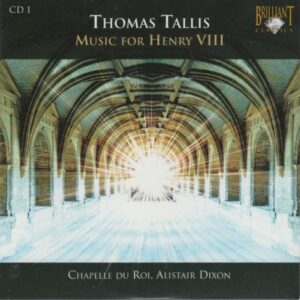 This morning, when I sallied forth to a nearby Panera restaurant, it was 7:15, the temperature was a surprisingly pleasant (especially for Michigan in early March!) 50 degrees, and the sun was just about to rise.
This morning, when I sallied forth to a nearby Panera restaurant, it was 7:15, the temperature was a surprisingly pleasant (especially for Michigan in early March!) 50 degrees, and the sun was just about to rise.
I had no idea what to expect from Thomas Tallis.
The only time I’d ever heard his name was when I bought the CD box set many years ago and waited for such a time as this to listen to its contents.
So, I bought a medium cup of Light Roast coffee, settled into a booth near a window, and hit the Play button on my MacBook Pro. (I had ripped the first five Tallis CDs into my laptop last night.)
It was still early enough that I was the one of maybe a half dozen people in the restaurant.
Just the way I like it.
 As is the case with many (most?) of the CD box sets I own, this 10-disc set was released by the exceptional label Brilliant Classics, which used to be known for its complete works editions. (They don’t seem to publish as many complete works editions these days. I don’t know why. I think they should.)
As is the case with many (most?) of the CD box sets I own, this 10-disc set was released by the exceptional label Brilliant Classics, which used to be known for its complete works editions. (They don’t seem to publish as many complete works editions these days. I don’t know why. I think they should.)
Brilliant Classics lives up to its name. They produce high-quality music, well recorded and well performed, at an extremely reasonable price. Sure, they’re no Deutsche Grammophon or Philips or EMI (to be fair, Philips and EMI are no longer Philips and EMI, either, having been bought out by a larger label years ago). But that’s only because people sometimes equate low price with low quality.
Snobs.
Brilliant Classics has never steered me wrong. They’re a great music label.
So, here I sit with Millard J. Erickson’s systematic theology textbook and Thomas Tallis ready to serenade me with the first of 10 CDs in the Brilliant Classics box set.
CD 1 is titled “Music for Henry VIII.”
Really?
Did Thomas Tallis really compose this for the infamous King Henry VIII? Or was it already in existence during Henry VIII’s time? Was the title of this CD applied by the person (or persons) who compiled it and/or recorded it?
Let’s do the math.
According to his entry on Wikipedia, Thomas Tallis was born around the year 1505. He died in 1585.
He,
was an English composer of High Renaissance music. His compositions are primarily vocal, and he occupies a primary place in anthologies of English choral music. Tallis is considered one of England’s greatest composers and is honoured for his original voice in English musicianship.
I didn’t read this about Tallis until after I’d already started listening to his music.
Since I didn’t know what to expect from Tallis, I was surprised to hear nothing but what sounded like Gregorian chant music. If not that precise, then certainly the kind of chanting performed by monks in monasteries. (I know because I’ve heard it with my own ears, having several times visited one of the more famous monasteries in America.)
King Henry VIII was born in 1457 and he died in 1509. The overlap of the infamous king and the birth of Thomas Tallis was only a scant four years (approximately 1505 for the birth of Tallis vs. 1509 for the death of the King of England). So, I suppose it’s possible Tallis composed this in homage to King Henry VIII. But the king never heard it during his lifetime.
So what is this music?
Well, Track One is titled “Ave Dei Patris Filia” and it is 15:32 that is called a “magnificent polyphonic hymn to the Virgin Mary” by an interesting web site called Orthodox in the District: Living the Ancient Faith in the Nation’s Capital.
The song begins (in English) with these words:
Hail, most noble daughter of God the Father,
most worthy mater of the Son of God,
most graceful bride of God’s Spirit,
closest servant of God one and three.
Hail, most clement daughter of the highest Eternity,
most blessed mother of the highest Truth,
most benign bride of the highest Kindness,
meekest servant of the highest Trinity.
One of the reasons why I like explore these Classical composers is to discover new forms of music, new musicians, new conductors, and new ways to let my imagination soar.
So far, I’ve discovered Thomas Tallis was born 519 years ago, he wrote mostly choral music, no paintings exist of him from the time he was alive (so nobody knows what he looked like), his music is being performed on this CD by Chapelle du Roi, “an ensemble of eight singers, many of whom are in the first few years of their professional careers. The choir specialises in performing and recording sacred music of the late medieval, and Renaissance periods,” under the direction of Alistair Dixon, according to their web site.
Alistair Dixon, also according to the aforementioned web site, “was born in 1961 and brought up in Ware, Hertfordshire. He was educated as a music scholar at Millfield School in Somerset where he studied the violin and organ. He graduated from Liverpool University in 1982 having continued his organ studies with Noel Rawsthorne and Ian Tracey.”
I also discovered that these recordings of Thomas Tallis’ music, performed by Chapelle du Roi and conducted by Alistair Dixon, were recorded between 1996 and 2004, and licensed by Signum Records, which is owned by Alistair Dixon. They first appeared as a 9-CD set released by Signum in early 2005 before (I presume) Brilliant Classics licensed them for release on their own label in the box set to which I now listen.
Just the Facts
CD 1 consists of 10 tracks that total 71:52 minutes.
Apparently, they were recorded digitally and mastered digitally (“DDD” appears on the back of the sleeve).
They all appear to be in Latin, and all are known as sacred music.
The Brilliant Classics box sets includes a free CD ROM that contains liner notes, lyrics., etc.
Just the Feelings
Recording quality: 5
Overall musicianship/vocals: 5
CD liner notes: 5
How does this make me feel: 5
When I first heard this CD, I left it on Repeat for a few hours, which means I heard it through at least 2-3 times. Because of that, I have a pretty good feel for the music.
This is a first-rate recording of first-rate performances. The liner notes are superb and answer many of my questions regarding who Tallis was and when his music was written. Since he lived five centuries ago, there isn’t much of a factual nature that can be verified. So people don’t really know when, precisely, he wrote his music.
The vocals remind me of being at the Abbey of Our Lady of Gethsemani, listening to the monks, and wiping sleep from my eyes at 3am for Vigils, the first office of the day in the life of a Trappist monk.
Overall, the songs tend to blend together, so it’s not easy to tell when one ends and the next one begins. The effect is kind of a wall of sound that ebbs and flows, with female voices providing a very nice upper register that soars above the male voices. It provides a tremendous spiritual backdrop for doing, well, spiritual things.
This is fine music to play as background during which one reads or types or studies or even prays. It’s not necessarily music for active listening. At least, it’s not that for me.
Your mileage may vary.
